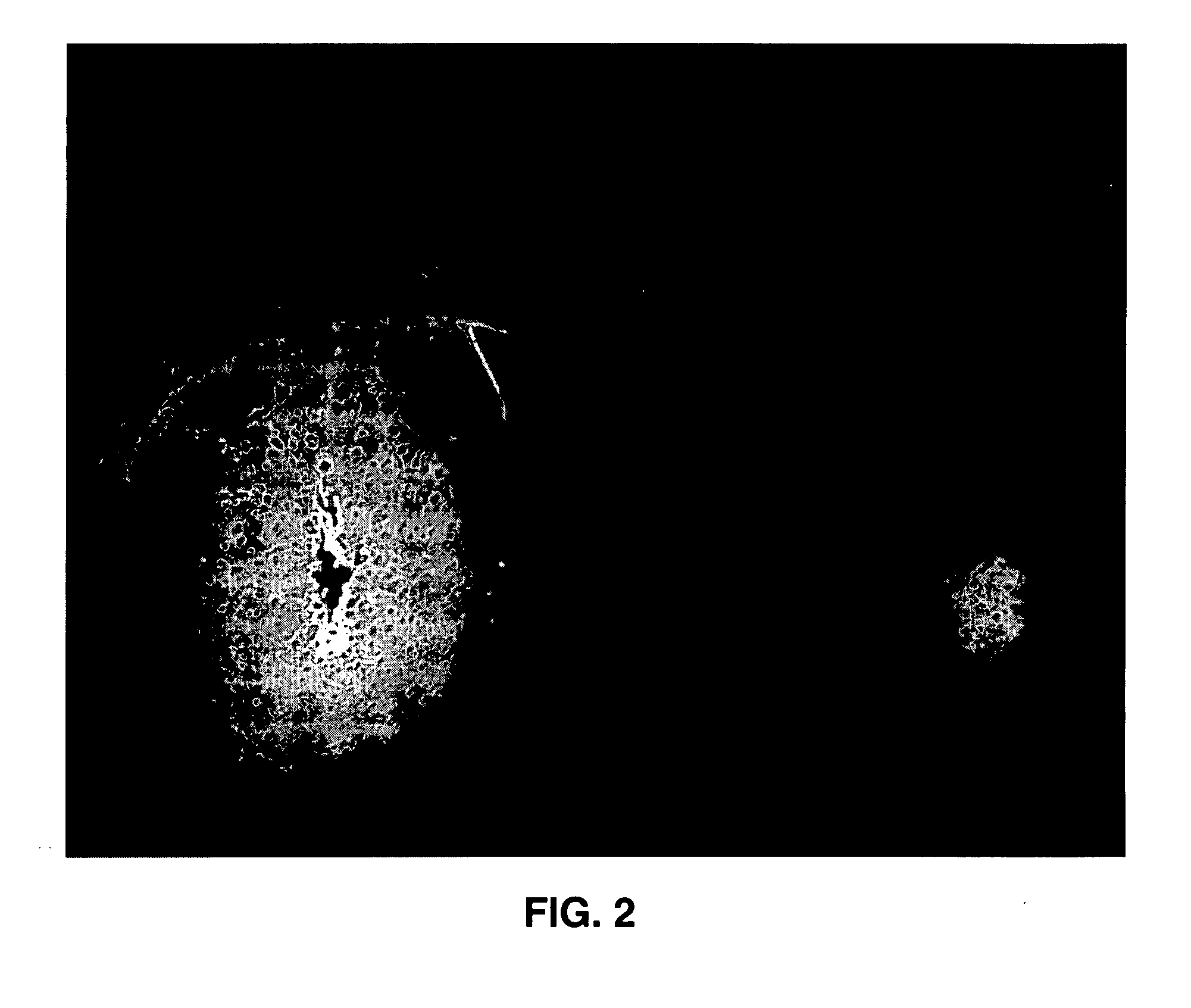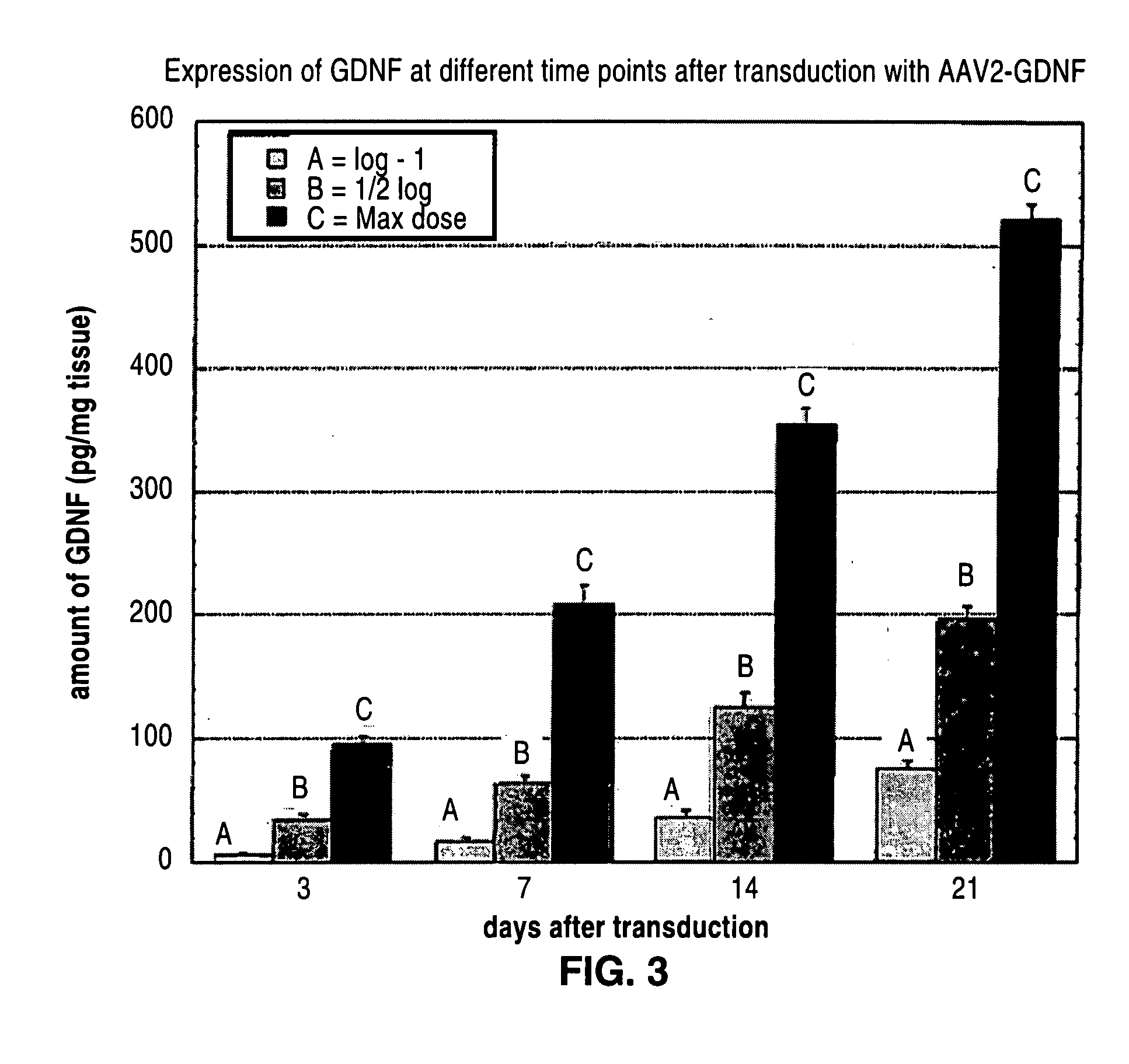Administration of growth factors for the treatment of CNS disorders
a growth factor and cns disorder technology, applied in the field of neurodegenerative diseases, can solve the problems of undesirable secondary effects, adverse effects of continuous administration, accumulation of growth factors, etc., and achieve the effect of reducing the severity of cns disorders and preventing or delaying the onset of cns disorders
- Summary
- Abstract
- Description
- Claims
- Application Information
AI Technical Summary
Benefits of technology
Problems solved by technology
Method used
Image
Examples
example 1
GDNF Expression in the Rat Striatum After CED of AAV2-GDNF
[0259] AAV2-GDNF was infused into the striatum at different doses and rats were euthanized at different time points to analyze accumulation of GDNF expression. GDNF was measured by ELISA.
AAV2-GDNF (from Avigen)=1.1 e 13 vg / ml (PBS+0.001% pluronic F68)
[0260] 3 different doses were chosen: [0261] 15 ml#max=1.65 e 11 vg [1.1 e 13 vg / ml][0262] 15 ml#½ log=9.07 e 10 vg [6.05 e 12 vg / ml][0263] 15 ml# log−1=1.65 e 10 vg [1.1 e 12 vg / ml]
[0264] 7 rats per time point:
[0265] group A: 4 rats Lhemisph: max / Rhemisph: ½ log [3 for ELISA, 1 for IHC]
[0266] group B: 3 rats Lhemisph: log−1 Rhemisph: AAV2-LacZ (control) [3 for ELISA]
[0267] CED—infusion rate: 0.2 μl / min=11 min [0268] 0.5 μl / min=8 min [0269] 0.8 μl / min=11 min [0270] 15 μl 30 min
[0271] Results are provided in Table 4 and in FIG. 3, which demonstrate a gradual accumulation of GDNF over time.
example 2
Evaluation of GDNF Protein Delivery in Treatment of Parkinson's Disease
[0272] Single-dose administration of GDNF into monkey putamen results in prolonged tissue levels of GDNF that can last for longer than several weeks (FIG. 4).
[0273] In order to understand frequency and dose level of local administration of GDNF with convection-enhanced delivery (CED), the relationship between administration of a single dose and tissue half-life and biological effects (FIG. 4) is established. Further studies in MPTP monkeys with functional evaluation and PET imaging are optionally also done to further characterize the pharmacokinetics of locally administered GDNF in PD monkeys.
[0274] A dose-finding study in normal Rhesus monkeys to establish the magnitude and duration of response in dose-dependent fashion is done.
[0275] Thirty-nine (39) animals are used and divided into cohorts of 3 animals. Each cohort receives unilaterally a dose of 10, 50 or 100 μg of GDNF into 2 sites in the putamen.
[0276...
example 3
Evaluation of GDNF Expression in Rat Striatum
[0348] AAV2-GDNF was infused (CED) into the rat striatum at different doses and rats were euthanized at different time points to analyze correlation with the level of GDNF expression overtime. Both hemispheres were infused with a proper amount of AAV2-GDNF in a total volume of 15 μl. The test groups are illustrated in FIG. 8.
[0349] Standard surgical procedures for intrastriatal CED were performed with the following infusion rates: 0.2 μl / min for 11 min, 0.5 μl / min for 8 min, and 0.8 μl / min for 11 min. Concentration of GDNF protein in striatal tissue was determined by ELISA. Following euthanasia, the brains were rapidly removed and the striatum was dissected bilaterally and immediately frozen. The samples were homogenized and exposed to acidification treatment. Tissue level of GDNF was determined in homogenates by GDNF Emax® Immunoassay System (Promega). To confirm GDNF expression, one rat from group A was used for immunohistochemical ev...
PUM
| Property | Measurement | Unit |
|---|---|---|
| Time | aaaaa | aaaaa |
| Time | aaaaa | aaaaa |
| Volume | aaaaa | aaaaa |
Abstract
Description
Claims
Application Information
 Login to View More
Login to View More - R&D
- Intellectual Property
- Life Sciences
- Materials
- Tech Scout
- Unparalleled Data Quality
- Higher Quality Content
- 60% Fewer Hallucinations
Browse by: Latest US Patents, China's latest patents, Technical Efficacy Thesaurus, Application Domain, Technology Topic, Popular Technical Reports.
© 2025 PatSnap. All rights reserved.Legal|Privacy policy|Modern Slavery Act Transparency Statement|Sitemap|About US| Contact US: help@patsnap.com



